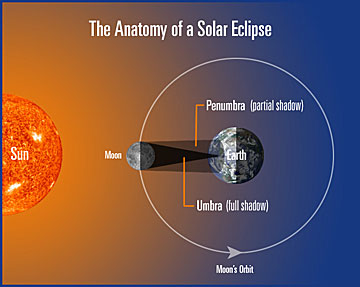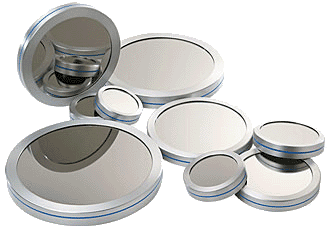
The Solar Eclipse March 29, 2006
In its monthly trip around the Earth, the Moon passes close to the Sun every New Moon. Because the plane of the Moon's orbit is at an angle to that of the Earth's orbit around the Sun, most of the time the Moon passes either above or below the Sun. When the timing is just right, the Moon actually blocks the light from the Sun, resulting in an eclipse.

Because the shadow of the Moon is very small on the Earth's surface, you need to be in exactly the right place at exactly the right time to see a total eclipse. The next time this happens is on March 29.
Because the Earth and Moon are both in motion, the tiny dot of shadow, only 184 km in diameter, passes in a long narrow path across the face of the Earth.
 Eclipse map courtesy of Fred Espenak, NASA/Goddard Space Flight Center
Eclipse map courtesy of Fred Espenak, NASA/Goddard Space Flight Center
The Moon's shadow touches down at sunrise on the extreme eastern tip of Brazil and immediately heads out over the Atlantic Ocean. It makes landfall in Ghana and travels northeastward across the Sahara, passing through Libya and the extreme northwestern corner of Egypt. Crossing the Mediterranean, it moves in between Crete and Cyprus without touching either, and then crosses Turkey, the Black Sea, Georgia, Russia, the Caspian Sea, Kazakhstan, and Russia again before leaving the Earth at sunset in Mongolia. The best places to observe the eclipse along this path are in Libya (where Jim Low and I will be), the Mediterranean (where many cruise ships will be located), and Turkey. These are the places where the Sun will be highest in the sky and the weather prospects the best. At the point of maximum eclipse, in southern Libya, totality will last 4 minutes and 7 seconds.
The Moon's path on the above map has a rather strange shape because the Earth is rotating as the Moon's shadow sweeps in a straight line across it.
Even though the Moon's shadow will be 184 km in diameter, most observers will be concentrated along a line right in the middle of this path, so as to get the maximum length of eclipse and the most spectacular views. Here they will watch as the Moon slowly moves in front of the Sun's face until it is almost totally covered, the only light visible being the few scattered beams working their way through valleys at the Moon's edge, called Baily's Beads. Then, all light from the Sun's photosphere will be gone, the sky will become dark enough to see bright stars and planets, and all that will be visible of the Sun will be prominences close to the Moon, and the ghostly glow of the Sun's outer atmosphere, the corona. It used to be that these were only visible during eclipses, but nowadays solar telescopes are widely available to view prominences any time. But the corona is still visible only during a total eclipse, and it is to see the corona that people will travel halfway around the world.
Observing a solar eclipse requires relatively simple equipment. Viewing the partial phases requires normal solar filters to cut the Sun's heat and light to manageable levels. Naked eye observers often use #14 welder's glass, the greatest density made. This is usually available only from specialized welding supply dealers. Solar filters for telescopes are widely available from most telescope dealers.

It's important to be prepared and have proper solar filters; last minute improvisations can be extremely hazardous and can lead to permanent blindness. With the proper filters, observing a solar eclipse is perfectly safe.
At the moment of totality, once the Sun's photosphere is completely covered by the Moon, it is safe to remove the filters from your eyes or telescope. Only without filters will you see the light of the corona, the whole reason for traveling to an eclipse.

I plan to do something a little different to observe this eclipse. Instead of a normal white light telescope, I plan to use my Coronado HST hydrogen-alpha telescope. This will enable me to watch the activity of the hydrogen in the Sun?s upper atmosphere during the partial phases. At totality, I will switch to my 10x50 binoculars to view the corona and to look for stars and planets near the eclipsed Sun.
Wish me luck!
March 2006
Geoff has been a life-long telescope addict, and is active in many areas of visual observation; he is a moderator of the Yahoo "Talking Telescopes" group.






 /
/ 







